To get certified for aerial photography, you'll need to obtain a Remote Pilot Certificate from the FAA. Start by studying for the Part 107 aeronautical knowledge test, which covers topics like airspace regulations, weather, and flight operations. Once you pass the exam, complete a TSA background check and apply for your certificate through IACRA. Register your drone if it weighs between 0.55 and 55 pounds. Master flight controls and practice safe operations, including staying below 400 feet and maintaining visual line of sight. Don't forget to acquire proper insurance coverage for your equipment and operations. The journey to becoming a certified aerial photographer doesn't end here; there's much more to explore in this exciting field.
Key Takeaways
- Obtain a Remote Pilot Certificate by passing the FAA's Part 107 aeronautical knowledge test.
- Register your drone with the FAA if it weighs between 0.55 and 55 pounds.
- Study aeronautical topics, including airspace classifications, weather patterns, and FAA regulations.
- Master drone flight controls and practice advanced maneuvers for effective aerial photography.
- Acquire necessary insurance coverage, including liability and equipment insurance for your drone operations.
Understanding FAA Drone Regulations
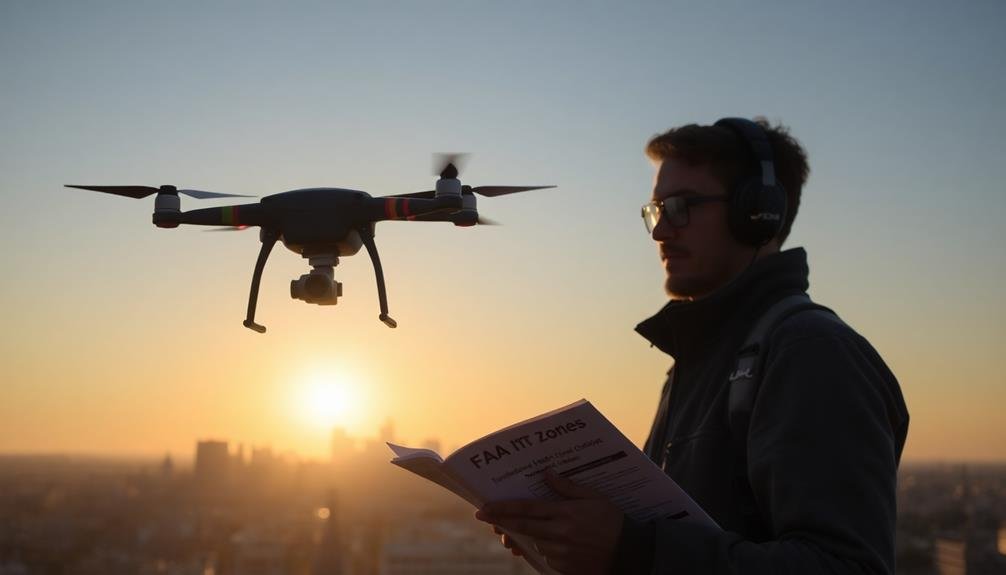
Maneuvering the maze of FAA drone regulations is vital for aspiring aerial photographers. You'll need to familiarize yourself with Part 107 of the Federal Aviation Regulations, which governs the commercial use of small unmanned aircraft systems (sUAS). This regulation covers everything from registration requirements to operational limitations.
First, you must register your drone with the FAA if it weighs between 0.55 and 55 pounds. You'll also need to obtain a Remote Pilot Certificate by passing an aeronautical knowledge test. This exam covers topics like airspace classification, weather patterns, and emergency procedures.
Once certified, you must follow specific operational rules. These include flying only during daylight hours, keeping your drone within visual line of sight, and maintaining an altitude below 400 feet above ground level.
You're prohibited from flying over people or moving vehicles without special waivers.
It's important to stay updated on changing regulations and local laws. Some areas may have additional restrictions or require special permits for aerial photography.
Always check for temporary flight restrictions before each flight to confirm you're operating legally and safely.
Obtaining a Remote Pilot Certificate
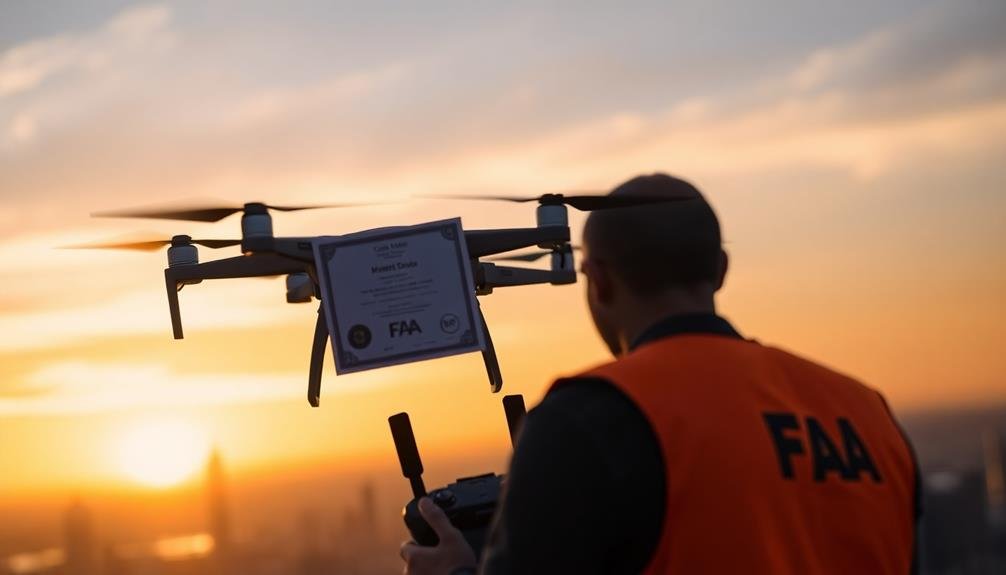
To obtain your Remote Pilot Certificate, you'll need to meet the FAA Part 107 requirements.
You can access extensive study materials and resources through the FAA's website and various online platforms. Prepare thoroughly for the knowledge test, which covers topics like airspace classification, weather patterns, and drone operations.
FAA Part 107 Requirements
If you're serious about pursuing aerial photography as a commercial venture, you'll need to obtain a Remote Pilot Certificate under the FAA's Part 107 regulations. This certificate allows you to legally operate small unmanned aircraft systems (sUAS) for commercial purposes.
To meet the Part 107 requirements, you must be at least 16 years old and able to read, speak, write, and understand English. You'll need to pass an aeronautical knowledge test at an FAA-approved testing center. This test covers topics such as airspace classification, weather patterns, drone operations, and emergency procedures.
Before taking the test, study the provided materials thoroughly. The FAA offers free study guides and sample questions online.
You'll also need to undergo a TSA background check to guarantee you don't pose a security risk.
Once you've passed the test and cleared the background check, you can apply for your Remote Pilot Certificate through the FAA's Integrated Airman Certification and Rating Application (IACRA) system.
After approval, you'll receive your temporary certificate electronically, with the permanent card arriving by mail within 120 days.
Study Materials and Resources
Preparing for the FAA Part 107 test requires access to quality study materials and resources. To excel in your exam, you'll need to immerse yourself in various topics, including airspace classifications, weather patterns, drone regulations, and operational procedures.
Start with the FAA's official study guide, the "Remote Pilot – Small Unmanned Aircraft Systems Study Guide." It's free and covers all essential topics for the test. Supplement this with online practice exams, which simulate the actual test environment and help you identify areas that need improvement.
Consider investing in specialized Part 107 study courses offered by reputable providers. These often include video lessons, practice questions, and study aids tailored to the exam. YouTube channels dedicated to drone education can also be valuable resources, offering explanations of complex concepts and test-taking strategies.
Join online forums and communities for aspiring drone pilots. These platforms allow you to interact with experienced pilots, ask questions, and share study tips.
Don't forget to review the FAA's Aeronautical Charts and the Pilot's Handbook of Aeronautical Knowledge for in-depth understanding of airspace and aviation principles. With these resources, you'll be well-prepared for your Part 107 certification.
Studying Aeronautical Knowledge Test Topics
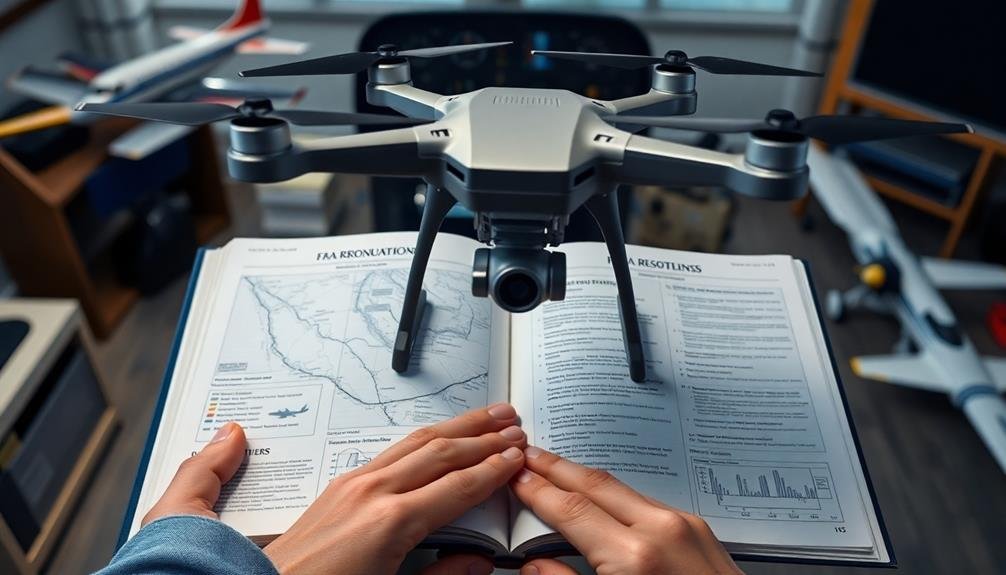
Aspiring aerial photographers frequently overlook the importance of studying for the Aeronautical Knowledge Test. This vital exam covers a wide range of topics essential for safe and legal drone operation. You'll need to focus on airspace classifications, weather patterns, and flight regulations.
Start by familiarizing yourself with aeronautical charts and airspace restrictions. You'll need to understand how to read these charts and identify different types of airspace.
Weather knowledge is also significant, so study atmospheric conditions, cloud formations, and how they affect drone flights.
Next, explore flight operations and procedures. Learn about pre-flight inspections, emergency protocols, and proper radio communication.
You'll also need to understand basic aerodynamics and how they apply to drones.
Don't forget to study FAA regulations thoroughly. This includes knowledge of Part 107 rules, waiver processes, and privacy laws.
Registering Your Drone
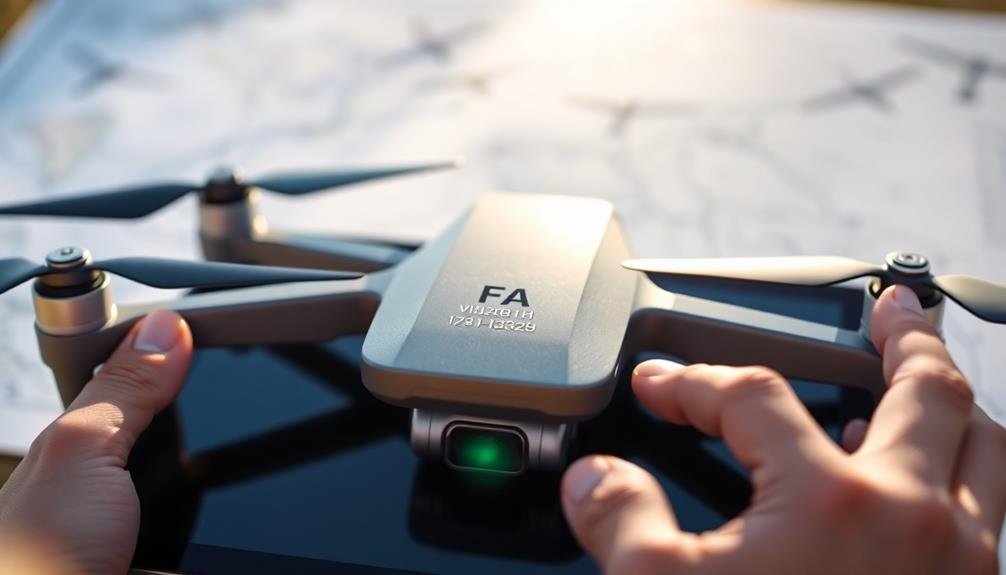
Once you've mastered the necessary aeronautical knowledge, you'll need to register your drone with the Federal Aviation Administration (FAA). This process is straightforward and can be completed online through the FAA's DroneZone portal.
You'll need to provide basic information about yourself and your drone, including its make, model, and serial number.
For drones weighing between 0.55 and 55 pounds, you'll register under the "Fly for Fun" category if you're using it recreationally, or "Fly for Work" if you're conducting commercial operations.
The registration fee is $5 and is valid for three years. After completing the registration, you'll receive a unique identification number that must be displayed on your drone.
If your drone weighs more than 55 pounds, you'll need to register it using the FAA's paper-based process. This involves filling out Form AC 8050-1 and mailing it to the FAA's Aircraft Registration Branch.
Keep in mind that larger drones may require additional certifications and approvals.
Remember to renew your registration before it expires to maintain compliance with FAA regulations. Failure to register your drone can result in civil and criminal penalties.
Mastering Drone Flight Controls
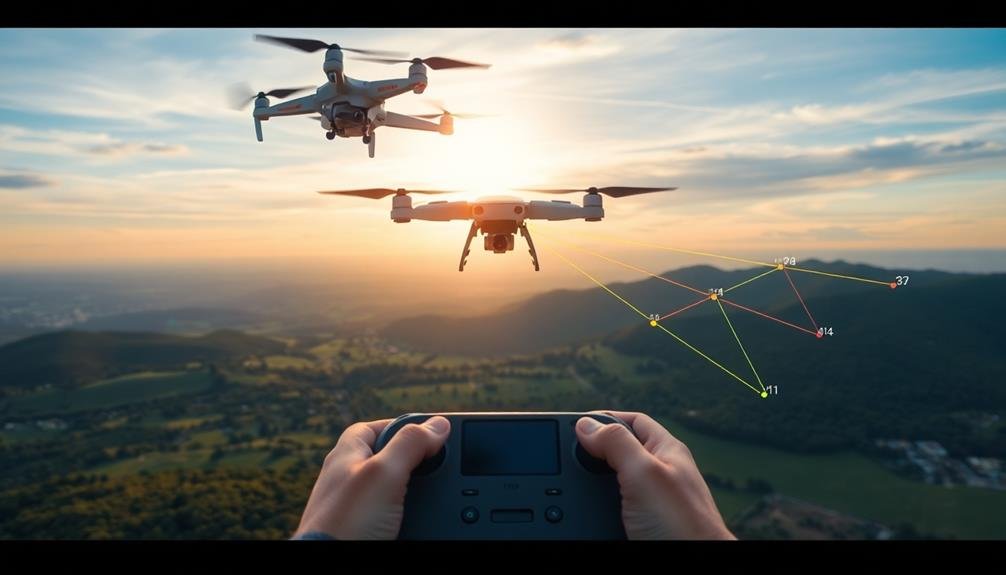
To master drone flight controls, you'll need to start with the basics. Familiarize yourself with the primary controls for altitude, yaw, pitch, and roll, ensuring you can execute smooth movements in all directions.
Once you've got the fundamentals down, practice advanced maneuvers like figure-eights, orbits, and precise hovering to improve your aerial photography skills.
Basic Controls Overview
Mastering drone flight controls is the cornerstone of aerial photography certification. You'll need to familiarize yourself with the basic controls of your drone to operate it safely and efficiently.
The two main control sticks on your remote controller are vital: the left stick controls altitude and yaw, while the right stick manages pitch and roll.
The left stick's vertical movement adjusts the drone's height, and its horizontal movement rotates the aircraft left or right. The right stick's vertical movement tilts the drone forward or backward, affecting its speed and direction. Moving it horizontally makes the drone fly sideways.
You'll also find additional buttons and switches for functions like takeoff, landing, return-to-home, and camera controls. Most drones have a dedicated button to start and stop video recording, and another to capture still photos. Some advanced models feature programmable buttons you can customize for specific functions.
It's essential to practice these controls in an open area, starting with basic maneuvers before progressing to more complex movements.
As you gain proficiency, you'll be better equipped to capture stunning aerial footage and pass your certification exams.
Advanced Maneuvers Practice
After grasping the basic controls, you'll need to hone your skills with advanced maneuvers. Focus on mastering precise movements and complex flight patterns essential for aerial photography. Practice flying in figure-eight patterns, maintaining a consistent altitude and speed throughout.
Work on smooth changes between different altitudes and speeds, as these skills are vital for capturing dynamic shots. Learn to execute perfect hover maneuvers, keeping your drone stable in various wind conditions.
Practice orbiting techniques, where you circle a subject while keeping it centered in your frame. Master the art of tracking moving subjects, maintaining a constant distance and angle. Experiment with different camera angles by tilting the drone during flight.
Incorporate obstacle avoidance exercises into your practice routine. Set up a course with various objects and practice maneuvering through tight spaces.
Work on your situational awareness by flying with reduced visibility or in challenging environments. Don't forget to practice emergency procedures, such as rapid ascents or descents, and return-to-home functions.
Regular practice of these advanced maneuvers will greatly improve your aerial photography skills and increase your chances of certification success.
Learning Aerial Photography Techniques
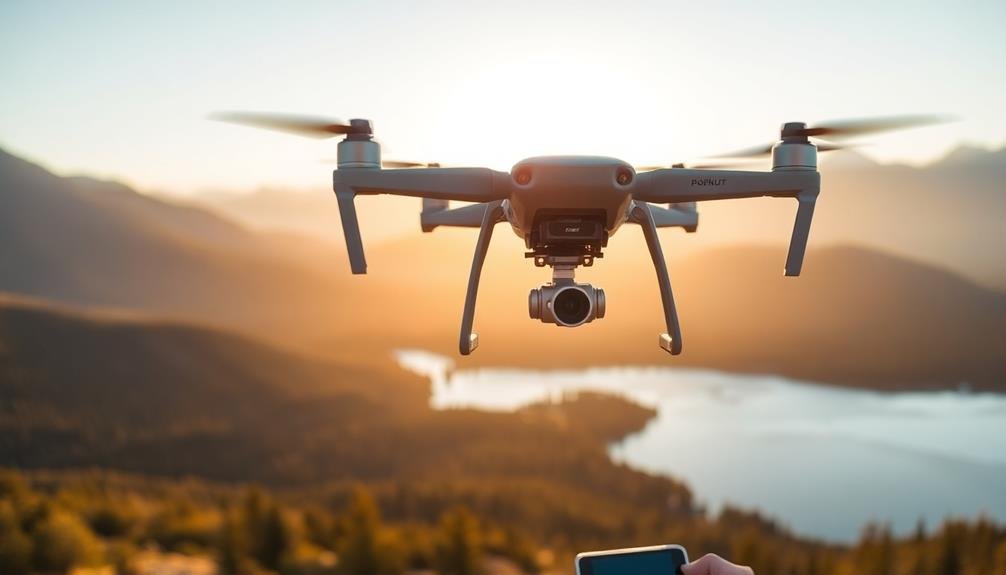
While gaining certification is essential, learning aerial photography techniques is equally important for success in this field. You'll need to master composition, lighting, and camera settings specifically for aerial shots.
Start by practicing the rule of thirds and leading lines to create compelling aerial compositions. Pay attention to how light changes at different altitudes and times of day, and adjust your camera settings accordingly.
Experiment with various shutter speeds to capture motion or create a sense of stillness in your images. Learn to use filters, especially polarizing and neutral density filters, to enhance sky colors and control exposure.
Familiarize yourself with post-processing techniques tailored for aerial photography, such as correcting distortion and enhancing contrast. Practice shooting from different altitudes and angles to understand how perspective changes.
Learn to anticipate and capture fleeting moments, like interesting cloud formations or unique lighting conditions. Don't forget to take into account safety and legal requirements while shooting.
Practicing Safe Flight Operations
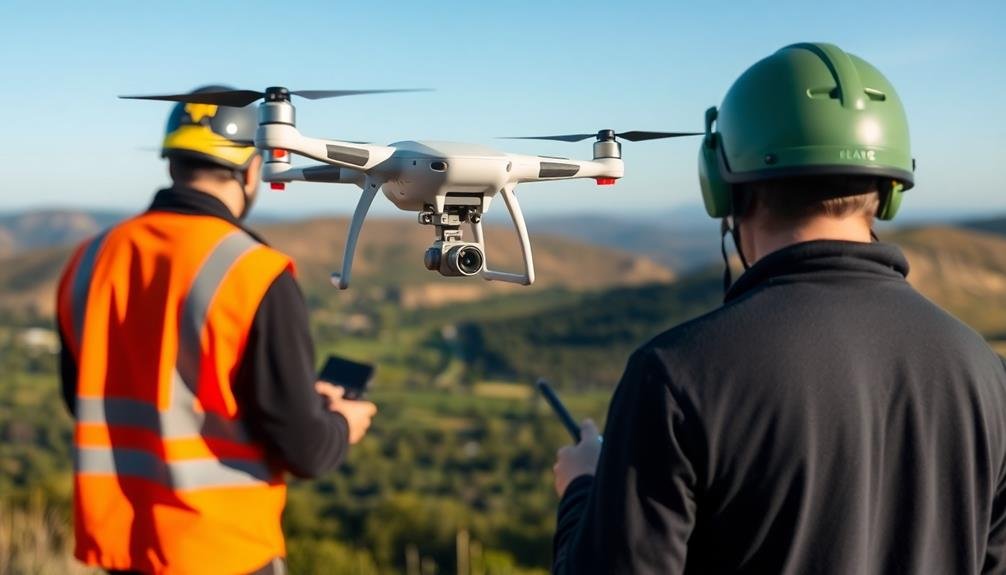
Safe flight operations are paramount in aerial photography. You'll need to familiarize yourself with local airspace regulations, weather patterns, and potential hazards before each flight.
Always conduct pre-flight checks on your equipment, including the drone's battery life, propellers, and camera settings. It's vital to maintain visual line of sight with your drone at all times and stay below the maximum altitude limits set by aviation authorities.
Be aware of your surroundings and avoid flying near airports, populated areas, or sensitive locations without proper authorization. You should also respect privacy laws and avoid capturing images of people or private property without consent.
When operating in challenging conditions, such as strong winds or low light, adjust your flight plan accordingly and be prepared to abort if necessary.
Develop an emergency response plan for situations like loss of control or battery failure. Practice emergency landings and learn how to safely recover your drone in various scenarios.
Acquiring Necessary Insurance Coverage
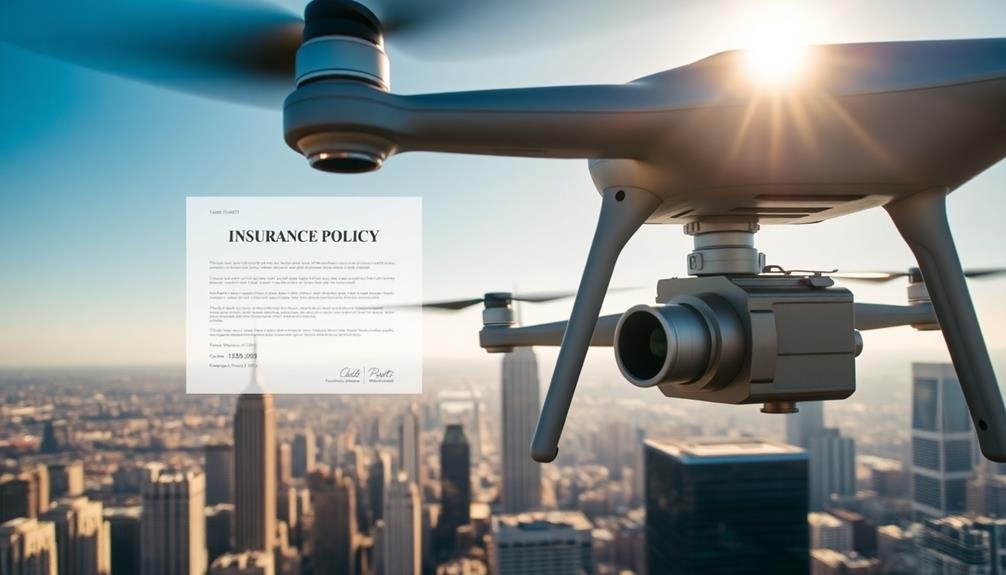
You'll need to secure appropriate insurance before operating as an aerial photographer.
Consider liability insurance, equipment coverage, and potentially hull insurance for your drone.
Research providers specializing in drone insurance to find policies tailored to your specific needs and budget.
Types of Insurance Needed
An aerial photographer's toolkit isn't complete without proper insurance coverage. You'll need several types of insurance to protect yourself and your business.
First, liability insurance is vital. It covers damage or injury you might cause to people or property during your aerial photography work. This includes accidents involving your drone or equipment falling and causing harm.
Next, you'll want equipment insurance. This protects your expensive camera gear, drones, and other tools of the trade from theft, damage, or loss.
Professional indemnity insurance is also essential, covering legal costs if a client sues you for errors or omissions in your work.
Don't forget about hull insurance for your drone. This covers damage to the drone itself, which can be costly to repair or replace.
If you're operating commercially, you may need commercial auto insurance to cover any vehicles used for your business.
Lastly, consider cyber liability insurance. As you'll be handling digital assets and client data, this protects you from potential breaches or data loss.
Coverage Amount Considerations
When determining insurance coverage amounts for your aerial photography business, several factors come into play.
You'll need to evaluate the value of your equipment, potential liability risks, and the scope of your operations. Don't skimp on coverage, as inadequate insurance can leave you vulnerable to significant financial losses.
To determine appropriate coverage amounts, assess these key factors:
- Equipment value: Calculate the total cost of your drones, cameras, and other gear.
- Liability exposure: Assess potential damages you might cause to property or people.
- Contract requirements: Check if clients or venues have specific insurance mandates.
- Business size and revenue: Larger operations typically require higher coverage limits.
Start with a general liability policy of at least $1 million, but be prepared to increase this based on your specific needs.
For equipment coverage, insure the full replacement value of your gear. If you're working with high-profile clients or in sensitive areas, you may need higher liability limits, possibly up to $5 million or more.
Finding Specialized Providers
With the unique risks associated with aerial photography, finding specialized insurance providers is crucial for adequate coverage. Start by researching insurance companies that specifically cater to drone operators and aerial photographers.
Look for providers with expertise in aviation and unmanned aerial systems (UAS) insurance. Consult professional organizations like the Professional Aerial Photographers Association (PAPA) or the Association for Unmanned Vehicle Systems International (AUVSI) for recommendations.
These groups often have partnerships with reputable insurers and can guide you towards trusted providers. Don't hesitate to reach out to multiple insurance companies for quotes.
Compare their offerings, coverage limits, and premiums to find the best fit for your needs. Ask about their experience insuring aerial photographers and their understanding of the industry's specific risks.
Consider working with an insurance broker who specializes in aviation or drone insurance. They can help you navigate the complexities of aerial photography coverage and potentially negotiate better rates or terms on your behalf.
Lastly, verify that the provider is licensed to operate in your state and has a solid financial rating. This confirms they'll be able to fulfill their obligations if you need to file a claim.
Joining Professional Drone Organizations
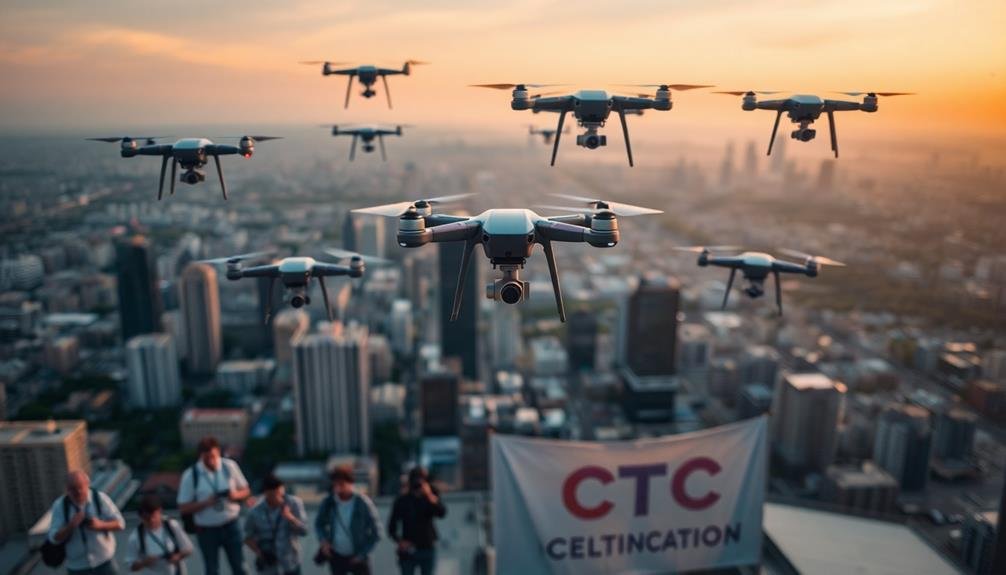
Frequently, aspiring aerial photographers overlook the benefits of joining professional drone organizations. These groups can provide invaluable resources, networking opportunities, and industry insights that'll help you advance your career.
By becoming a member, you'll gain access to a community of like-minded professionals who can offer guidance and support as you navigate the certification process.
When considering which organizations to join, look for those that focus on aerial photography and drone operations. These specialized groups often offer:
- Educational resources and training programs
- Updates on industry regulations and best practices
- Discounts on equipment and insurance
- Job boards and networking events
Don't hesitate to reach out to current members to learn about their experiences. Many organizations host local chapters or online forums where you can connect with other drone enthusiasts.
Attending meetings or participating in discussions can help you stay informed about the latest trends and technologies in aerial photography.
Continuing Education for Drone Pilots
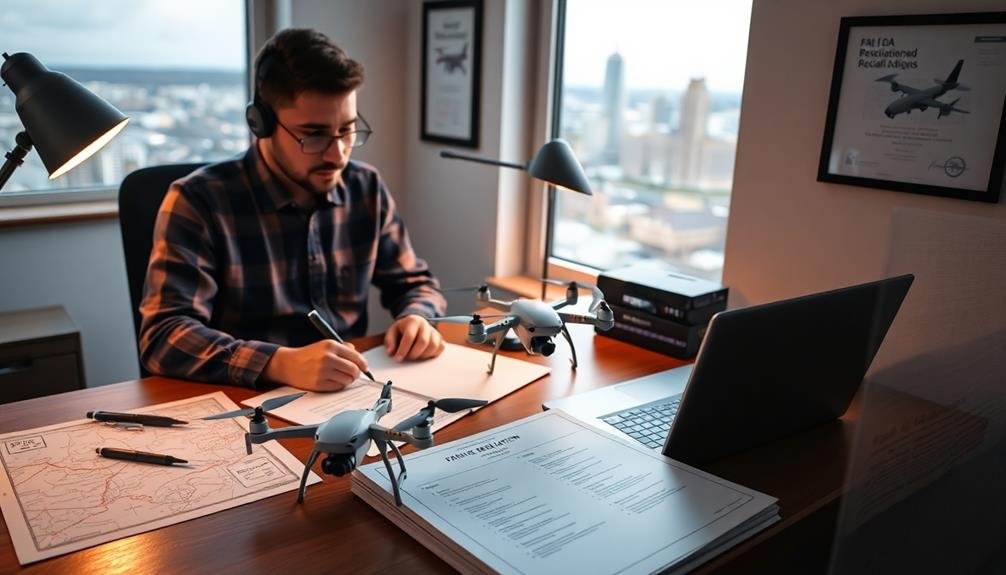
Beyond initial certification, continuing education is essential for drone pilots to stay competitive and compliant in the rapidly evolving field of aerial photography.
You'll need to keep up with the latest regulations, technology advancements, and industry best practices. The FAA requires recurrent training every 24 months for Part 107 certificate holders, which includes an online course and exam.
Look for workshops, webinars, and conferences focused on aerial photography techniques, drone piloting skills, and post-processing methods.
Many professional organizations offer specialized courses in areas like thermal imaging, photogrammetry, and cinematography. Consider pursuing additional certifications, such as the Trusted Operator Program (TOP) or UAS Thermography Certificate.
Stay informed about software updates for your drone and editing tools. Experiment with new equipment and accessories to expand your capabilities.
Network with other professionals and join online forums to share knowledge and experiences. Regularly practice flying in different conditions and environments to maintain and improve your skills.
Frequently Asked Questions
How Much Does Professional Aerial Photography Equipment Typically Cost?
You'll find professional aerial photography equipment costs vary widely. A basic setup with a quality drone, camera, and accessories can start around $2,000. High-end rigs for specialized work might run $10,000 or more. It's a significant investment.
What Are the Best Drones for Beginners in Aerial Photography?
You'll want to start with user-friendly drones like the DJI Mini 2 or Holy Stone HS720E. They're affordable, easy to fly, and offer good image quality. Don't forget to practice and familiarize yourself with local regulations.
How Long Does It Take to Become Proficient in Aerial Photography?
You'll need several months to become proficient in aerial photography. It depends on your dedication, practice frequency, and initial skill level. You'll improve faster if you're consistently flying, shooting, and editing your drone footage.
Are There Age Restrictions for Obtaining a Drone Pilot Certification?
You'll need to be at least 16 years old to get a drone pilot certification in the US. There's no upper age limit, but you must pass a knowledge test and meet other FAA requirements.
Can I Use My Aerial Photography Skills Internationally Without Additional Certifications?
You'll likely need additional certifications to use your aerial photography skills internationally. Each country has its own regulations for drone pilots. It's essential you research and comply with local laws before operating in foreign airspace.
In Summary
You're now well-equipped to start your aerial photography journey. Remember, certification is just the beginning. Keep honing your skills, stay updated on regulations, and prioritize safety in every flight. As you gain experience, you'll develop your unique style and build a impressive portfolio. Don't forget to network with other drone pilots and stay curious about new technologies. With dedication and practice, you'll soar to new heights in aerial photography.

As educators and advocates for responsible drone use, we’re committed to sharing our knowledge and expertise with aspiring aerial photographers.
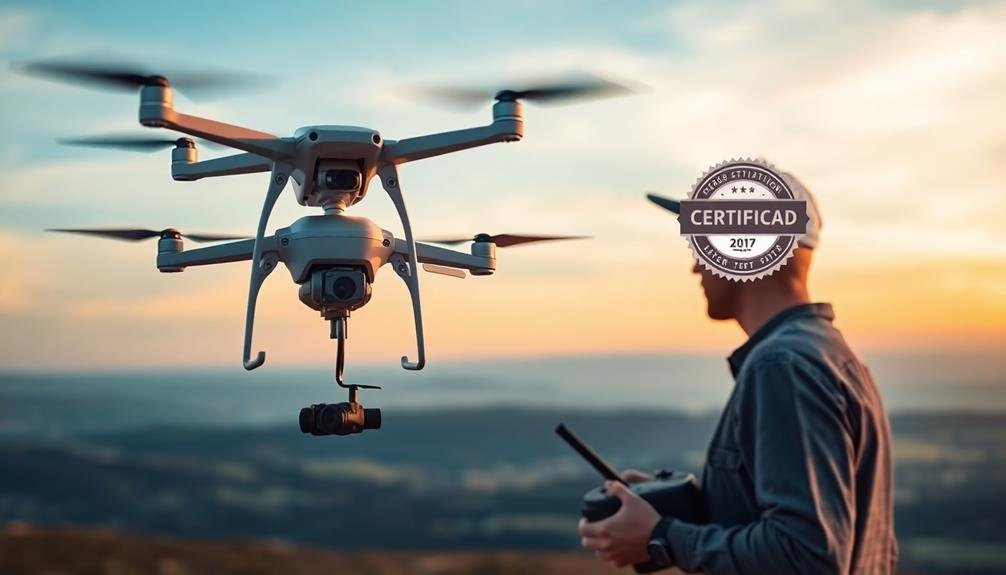



Leave a Reply